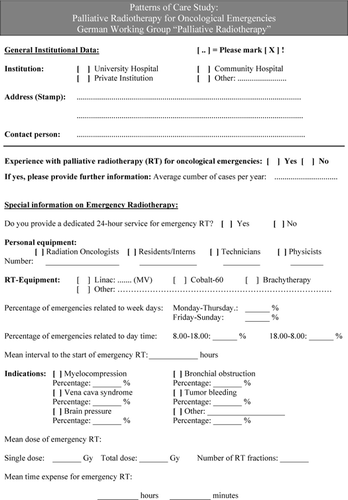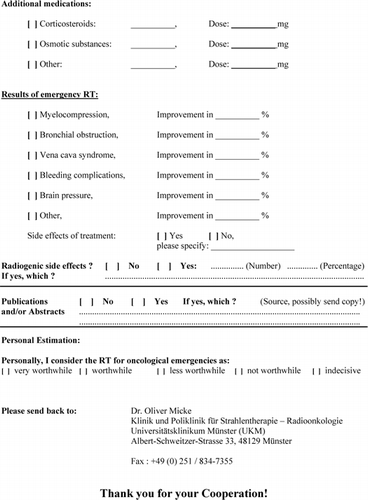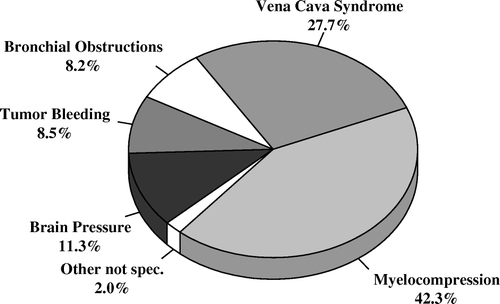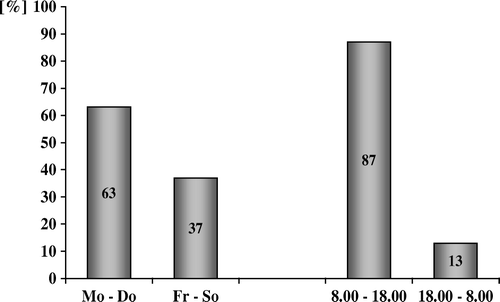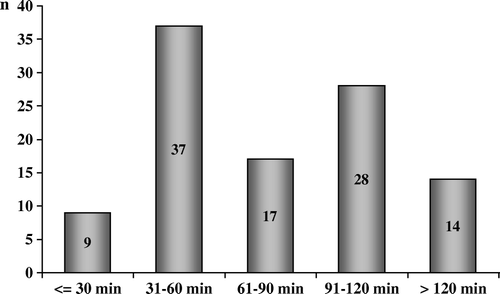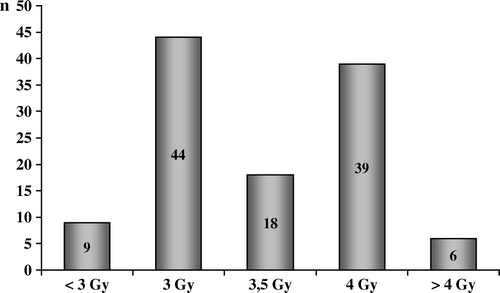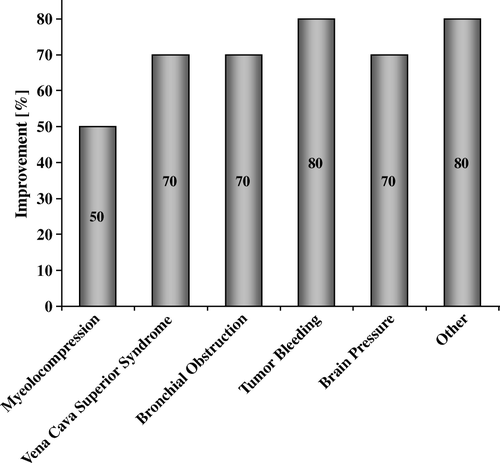Abstract
Radiotherapy (RT) is an important treatment option for emergencies in oncology. A multicenter patterns of care study (PCS) was conducted in all RT institutions in Germany, Austria and Switzerland.
In 2003 a standardized structured questionnaire was sent to all RT institutions. Number and type of staff involved, number of patients, over time distribution and expense, treatment indications and concepts of emergency RT were assessed. In addition, treatment outcome for the different indications was evaluated. The PCS was structured and analyzed according to the model for quality assessment set up by Donabedian in three major components: structure, process and outcome.
One hundred and forty institutions (70%) answered the questionnaire. For the baseline of 2003 a total of 3 244 emergency radiotherapy indications with a mean of 28 per institution were reported. Forty percent of all institutions provide a special 24 h service at night or weekends. Seventy percent of the emergency indications were irradiated between Monday and Thursday, 30% between Friday and Sunday. Ninety percent of all emergencies were referred to RT between 8 a.m. and 6 p.m., 10% between 6 p.m. and 8 a.m.
The applied doses for emergency RT ranged between 2 Gy and 8 Gy (median: 3.5 Gy). Time expense was reported with a median of 90 min.
The outcome analysis based on the treatment results of 1 033 patients: There was an improvement of myelocompression in 50% of the cases, vena cava superior compression in 70%, bronchial obstruction in 70% and bleedings in 80%. A clear dose-response relationship could not be established, but single doses of over 3 Gy in vena cava superior syndrome exhibited a significant advantage.
This study represents the largest database in literature on emergency RT. RT was shown to be fast, time sparing and a very effective treatment option for special oncological emergencies.
Emergency conditions in radiation oncology are a heterogeneous and ill-defined group of disorders with some authors even questioning if they really exist Citation[1], Citation[2].
Nevertheless, radiotherapy (RT) is one of the most important treatment options for emergencies in oncology. In particular it can be used in acute myelocompression, vena cava superior syndrome, bronchial obstruction, increased intracranial pressure due to brain metastasis and tumor bleeding complications Citation[3].
Generally, in oncological emergency conditions an immediate intervention is needed to preserve the patient's corporal integrity and quality of life and prevent the menacing deterioration of the patient's health conditions. Even the use of nights and weekends is at times necessary. Despite some reports about the high efficacy of radiation treatment for oncological emergencies, a standard of care is not well defined and the cost and personal intensity of this method is still controversial while the clinical value remains unclear. There are only a few publications in the literature dedicated primarily to emergency radiation oncology Citation[1–4].
Patterns of care studies (PCS) provide an important instrument for defining and evaluating treatment standards and quality assurance in radiation oncology; thereby, practice standards, treatment guidelines and accomplishments can be assessed continuously Citation[5–7].
For this purpose, the PCS have been established for a large variety of malignant as well benign conditions Citation[8].
Therefore, the German Working Group “Palliative Radiotherapy” of the German Society for Radiation Oncology (DEGRO) conducted a multi-center patterns of care study (PCS) in all RT institutions in Germany, Austria and Switzerland.
The aim of this PCS was to evaluate whether the instrument of PCS is suitable in this context and to analyze the standard of care applied in emergency RT.
Material and methods
In 2003, a Patterns of Care Study Panel of German Working Group “Palliative Radiotherapy” of the German Society for Radiation Oncology (DEGRO) developed a structured and standardized questionnaire (Appendix A) and mailed it to all RT departments in Germany, Austria and Switzerland with the aim of identifying their institutional experience with radiotherapy for oncological emergencies.
In this systematic approach the use of a dedicated 24-hour service, the number and type of staff involved, RT equipments, total number of patients, distribution over time, treatment indications, time expense and treatment concepts and of emergency RT was assessed. Treatment outcomes of the different emergency indications were analyzed. In case of unclear or incomplete data acquisition, interviews or visits to the institutions were applied to acquire the appropriate institutional and clinical information.
The relatively high response rate [140 (70%)] allowed an extensive and representative data analysis for Germany, Austria and Switzerland. A total of 1 033 patients were clinically retrospectively evaluated to obtain outcome data.
The statistical description of all relevant parameters included the median, mean, standard deviation, and range for all continuous variables, and the absolute and relative values for all categorical variables. The differences between the frequencies of groups were analyzed with the Fisher's exact and χ2 tests; the mean values of group frequencies were analyzed with the Student's t-test. All statistical analyses were performed using the commercially available program package SPSS 11.5.1 (SPSS, Chicago, IL).
As suggested by Hanks Citation[6], Citation[9] and Coia et al. Citation[10], this PCS was structured und analyzed according to the model for quality assessment instituted by Donabedian Citation[11], Citation[12] in three major components: structure, process and outcome.
To facilitate the outcome evaluation in the different participating institution, only crude outcome data as percentage were requested. This approach has been proven of value in prior PCS Citation[13–16].
Improvement was defined as a symptomatic response. A symptomatic response is defined by more than a 25% decrease of symptoms intensity.
To determine the interrelationship between these factors a multivariate analysis was performed by analysis of variance (ANOVA).
Results
Structural data
Of the 140 institutions participating in the survey, there were 37 university hospitals (26.4%), 88 community hospitals (62.9%), and 15 private institutions (10.7%) ().
Table I. Type and distribution of participating institutions.
As a baseline, in the year 2003, the participating institutions reported a total of 3 244 patients treated per annum with emergency RT. There was a median number of patients per institution of 18 (mean = 28) cases with a range between one and 220 cases. Emergency RT represented 3.1% of all RT indications of the participating RT facilities.
Overall, 126 (90%) RT institutions in Germany, 10 (7.1%) in Switzerland and 4 (2.9%) in Austria participated in the PCS.
The most frequent indications for emergency RT were acute myelocompression (42.3%), vena cava superior syndrome (27.7%), bronchial obstruction (8.2%), tumor bleeding (8.5%), increased brain pressure (11.3%) and other not specified indications (2%) ().
Process data
A total of 39.3% (55/140) of RT institutions provide a special dedicated 24-hour service at night or on weekends. During this period patients were evaluated and radiation treated.
This service was significantly more frequently provided in university hospitals (70.3%), compared to community hospital (28.4%) or private institutions (26.7%) (p < 0.001), whereas the distribution of emergency indications is nearly the same in all institution.
Nevertheless, the most emergency RT treatments were performed in community hospitals (1 833/3 244; 56.5%), followed by university hospitals (1 291/3 244; 39.8%). Only a minor percentage of emergency RT treatments were performed in private institutions (120/3 244; 3.7%).
A median of 70% of the emergency indications were irradiated between Monday and Thursday, 30% between Friday and Sunday. Overall, 90% of all emergencies presented in the RT departement between 8 a.m. and 6 p.m., while only 10% presented between 6 p.m. and 8 a.m. ().
The personal equipment held up for emergency RT consisted of 0.8 + 0.404 (mean + standard deviation) radiation oncologists, 0.48 + 0.504 residents/interns, and 0.41 + 0.567 technicians.
In 112 of 140 institutions (80%) the technical equipment for application of emergency RT consisted of linear accelerators, 25 (17.9%) used Cobalt-60 machines, 44 (31.4%) brachytherapy units, and eight (5.7%) not specified treatment units. Treatment simulators were generally not utilized, in the majority of patients treatment set-up was done clinically.
The median time interval between presentation of the patient for emergency RT and the beginning of RT was 2 hours (range: 0.5 to 36 hours).
The particular time expense was reported to be a median of 90 minutes (range. 20 to 180 minutes) ().
A special range of RT dose and fractionation concepts were applied. The dose used for single fractions at the commencement of emergency RT ranged from 2 to 8 Gy with a median dose of 3.5 Gy (). The most often used fractionation scheme was ten times 3 Gy (30 Gy total).
As additional medication 113 institutions (80.7%) gave corticosteroids with a median dose of 24 mg dexamethasone. Thirty institutions apply osmotic substances (21.4%) and 36 (25.7%) gave other non-specified medications.
Outcome data
A total of 117 (85.7%) institutions provided detailed data for clinical evaluation of treatment outcome. Thus, clinical data and treatment results of 1 033 patients treated with emergency RT are retrospectively reported herein. The median improvement rates in myleocompression were reported to be 50%, 70% in vena cava syndrome, 70% in bronchial obstruction, 80% in tumor bleeding, 70% in brain pressure, and 80% in other indications ().
Sixty percent of all radiation oncologists in this national survey considered RT in oncological emergencies as a worthwhile and necessary treatment indication.
Interaction of components
There was no statistical relationship between country, type of institution, overall treatment concepts and outcome.
A clear dose-response relationship could not be established, although there was a weak significance (p = 0.048) favoring single doses of over 3 Gy in vena cava superior syndrome.
Relating the time interval until the start of emergency RT to outcome data, only vena cava superior syndrome showed a significant (p = 0.021) improved outcome with an earlier (≤2 hours) beginning of emergency radiation treatment. In all other treatment indications there was no significant difference in outcome.
Providing a special 24-hour service for emergency RT showed a tendency (p = 0.084) for a better outcome in spinal cord compression.
Discussion
Since their first implementation in the United States in 1973, the Patterns of Care Study (PCS) has been established as a valuable tool for periodic evaluation of the radiotherapy practice Citation[7], Citation[17]. Its primary function is, as the founder Simon Kramer stated, to improve the quality and accessibility of radiation care in the United States. To this end the PCS seeks to establish how and by whom radiation therapy is being practiced in the United States and to evaluate the factors, which affect the levels of care presently being delivered Citation[18]. Since these early steps, evaluation of the quality of care has become a most critical issue in the medical practice, and it is particularly important in the multidisciplinary management of cancer patients Citation[19], Citation[20]. Subsequently, the method of PCS was successfully transported to many other countries outside the USA, e.g. Japan and Germany Citation[21], Citation[22].
PCS analyzes the patient with regard to technical and interpersonal components with three criteria: structure, process and outcome Citation[11], Citation[12]. Understanding the relationships of these three factors leads to the measurement of quality in any specialty Citation[6].
One major concern against PCS is that one must rely on the statements of the participating institutions, which may be subjective or inaccurate. As demonstrated in our previous PCS reliable data can be produced by controlling inconsistent or non-plausible information Citation[13–16]. Furthermore PCS are able to provide a larger data base in disease, even if the incidence would not allow large prospective controlled clinical trials by a single or few institutions.
Our PCS describes the current status of emergency RT in Germany, Austria and Switzerland. It is the first and the largest examination to our knowledge on emergency RT in the literature.
Structure data
The structural analysis revealed that despite 3 244 emergency RT treatments per year in Germany, Austria and Switzerland, this only represent 3.1% of all RT indications. The distribution of academic versus non-academic institution (approximately 1:3) is similar to that described in the former general PCS and in other PCS on malignant or benign disorders Citation[8], Citation[10], Citation[21].
A significantly higher percentage of university hospitals provided a dedicated service for emergency RT, although the largest number of patients were treated by community hospitals, which primarily contribute to the national coverage with emergency RT.
The most frequent reported indication for emergency RT treatment was the malignant myelocompression, followed by vena cava superior syndrome, which are the most important indications reported in the literature Citation[1], Citation[3], Citation[4], Citation[23–27]. Other indications such as malignant brain pressure, bronchial obstructions or tumor bleeding play only a minor role Citation[1], Citation[3], Citation[4].
In our study the number of patients with spinal cord compression is low compared to vena cava superior compression. One reason can be that, the institutions follow the new recommendations to use primarily surgery in these indications and perform irradiation only in inoperable cases Citation[24], Citation[28].
Process data
About 40% of RT institutions provide a special dedicated 24-hour service at nights or on weekends. The service was significantly more frequently provided in university hospitals. Nevertheless, most emergency RT treatments were performed in community hospitals. This reflects the fact that the main coverage of radiation treatment and consequently of emergency RT is provided by community hospitals.
About a third of all emergency treatment was performed from Friday to Sunday. This data cannot prove or exclude the so called “Friday phenomenon”, the personal experience, that most indications for emergency RT were referred on Friday afternoons or evenings Citation[29].
Only 10% of all emergency RT treatments were carried out at night between 6 p.m. and 8 a.m. This is related to significant personal efforts, which may be questioned by the fact that only a minority of emergency RTs are performed at nights Citation[29]. From the standpoint of cost-effectiveness it is questionable to keep personnel on call during nights. On the other hand emergency radiotherapy should be available every day.
The applied technical equipment described in this PCS is predominated by linear accelerators (80%). Cobalt-60 units play only a minor role, corresponding to the decreasing part of Cobalt-60 machines in radiation oncology in the overlooked countries Citation[8].
Emergency RT can be provided within a median duration of 2 hours. This short duration is primarily important in patients with metastatic spinal cord compression. Even so, the prognosis for complete neurological restoration in these patients is poor, and it is known that a short interval between paresis and commencement of treatment is of prognostic relevance Citation[1], Citation[3], Citation[4], Citation[23], Citation[24], Citation[28], Citation[30].
A special dose range is applied with a strong tendency to give higher single doses at the beginning of the treatment. This is also described in the literature. The total dose and fractionation schedule should be tailored to the disease setting and the life expectancy of the patients in this palliative situation Citation[1], Citation[3], Citation[30], Citation[31].
Most institutions give corticosteroids in addition to radiation treatment, which is strongly recommended in the literature Citation[23], Citation[32].
Outcome
Outcome analysis in the context of PCS is an important tool to set up a national benchmark on treatment outcome, which can be expected from the use of RT in a specific disorders Citation[5], Citation[6], Citation[17].
In our PCS we observed the clinical data and treatment results of more than 1 000 patients treated by emergency RT, provided by a representative number of RT institutions. This is the largest collective reported in the literature.
Our study showed high improvement rates in vena cava superior syndrome and in tumor bleedings underlining the importance of RT for these indications Citation[32], Citation[33]. In myelocompression, emergency RT is less successful with only 50% improvement rate. This confirms that surgery in metastatic spinal cord compression is the first treatment option and only in cases where surgery is not applicable, should RT be used. There has been a remarkable change in the recommendations for the management of spinal cord compression in the last few years. Previously, RT was advised to be the primary treatment Citation[28]. In light of new studies the approach has been changed to a preference of primary surgical intervention followed by irradiation Citation[24].
We could not establish a clear dose-response relationship, but there was a weak significance favoring single doses of over 3 Gy in vena cava superior syndrome. Armstrong et al. reported similar results in a retrospective analysis of 125 patients. High initial-dose radiation therapy (3–4 Gy) yielded good symptomatic relief in less than 2 weeks in 70% of the patients, compared to conventional-dose fractionation (2 Gy daily for five weekly fractions) with a response of 56% Citation[25]. These findings were also supported by Egelmeers et al. Citation[26] in a smaller number of patients (n = 34), but the reported median overall survival was only 6 months. Kwok et al. recommend in rapidly progressing vena cava syndrome or otherwise unstable patients the initiation of radiation treatment on an emergent basis, even without a tissue diagnosis Citation[3]. On the other hand, it must be considered that a radiation treatment, even with a few high doses, can make the histological diagnosis difficult or impossible. Gauden Citation[27] even denies that vena cave superior compression induced by bronchogenic carcinoma is a real oncological emergency, because there is no observed mortality due to venous compression, a relatively low response rate and a poor survival outcome (6 months in responders and one months in non-responders).
Our multivariate analysis revealed a significant advantage for an earlier beginning in vena cava superior syndrome, which is controversial in the literature Citation[25–27], and a tendency toward a better outcome in spinal cord compression when a special 24-hour service for emergency RT is provided. Several authors describe a better outcome in spinal cord compression when radiation treatment is started earlier Citation[1], Citation[3], Citation[4], Citation[23], Citation[24], Citation[28], Citation[30].
Radiotherapy in emergencies is very important for daily oncology practice. Nevertheless there were only few reports in the literature mainly focusing on this special indication Citation[1–4]. Their clinical data support the findings in our study. Donato et al. Citation[1] treated 43 patients with superior vena cava syndrome, 37 patients with spinal cord compression, and 108 patients with endocranial hypertension secondary to brain metastasis with different radiation schedules. They concluded that histology, pretreatment and performance status were important prognostic factors for the response to therapy. Their results demonstrated no significant difference among different schedules of radiotherapy and confirmed the importance of radiotherapy for oncological emergencies. Similar conclusion came from Ozarda et al. Citation[2]. They generally recommend the use of hypofractioned schemes withhigher single doses in oncological emergencies. Wierecky and Bokemeyer unlined the importance of an immediate commencement of radiation or surgical treatment Citation[4]. Accurate diagnosis of the underlying etiology needs to be established before treatment. Interdisciplinary cooperation is crucial in this setting. Kwok et al. pointed Citation[3] out, that the optimal management hinges on efficient multidisciplinary evaluation and communication to arrive at a treatment plan tailored to the individual patient. Optimal management may include steroids, surgery, chemotherapy, or bronchoscopic intervention.
Conclusion
This study represents the largest database in literature on emergency RT. It was demonstrated that the instrument of PCS is also suitable in the context of emergency RT. RT could be shown to be fast, time sparing and very effective treatment option for special oncological emergencies. The delivery of radiation is accomplished by a variety of techniques and fractionation schedules. The selection of treatment technique and fractionation schedule should depend on the patient's condition and the disease entity, volume and site.
Acknowledgements
The authors and the German Working Group “Palliative Radiotherapy” of the German Society for Radiation Oncology (DEGRO) are grateful to all institutions and radiation oncologists who participated in this study. Their cooperation in providing information made this unique national survey possible.
References
- Donato V, Bonfili P, Bulzonetti N, Santarelli M, Osti MF, Tombolini V, et al. Radiation therapy for oncological emergencies. Anticancer Res 2001; 21: 2219–24
- Ozarda AT, Sheffield HC. Emergency radiotherapy. Tex Med 1968; 64: 84–7
- Kwok Y, Deyoung C, Garofalo M, Dhople A, Regine W. Radiation oncology emergencies. Hematol Oncol Clin North Am 2006; 20: 505–22
- Wierecky J, Bokemeyer C. Compression syndromes. Der Internist 2005; 46: 9–18
- Behrend SW, Coia LR. Patterns of care in radiation oncology. Semin Oncol Nurs 1999; 15: 303–12
- Hanks GE, Coia LR, Curry J. Patterns of care studies: Past, present, and future. Semin Radiat Oncol 1997; 7: 97–100
- Owen JB, Sedransk J, Pajak TF. National averages for process and outcome in radiation oncology: Methodology of the patterns of care study. Semin Radiat Oncol 1997; 7: 101–7
- Micke O, Seegenschmiedt MH. Radiation therapy for aggressive fibromatosis (desmoid tumors): Results of a national Patterns of Care Study. Int J Radiat Oncol Biol Phys 2005; 61: 882–91
- Hanks GE, Kramer S. The patterns of care study: A specialty effort to improve care. Applied Radiol 1983; 12: 69–75
- Coia LR, Gunderson LL, Haller D, Hoffman J, Mohiuddin M, Tepper JE, et al. Outcomes of patients receiving radiation for carcinoma of the rectum. Results of the 1988–1989 patterns of care study. Cancer 1999; 86: 1952–8
- Donabedian A. The quality of medical care: A concept in search of a definition. J Fam Pract 1979; 9: 277–84
- Donabedian A. The quality of care. How can it be assessed?. JAMA 1988; 260: 1743–8
- Micke O, Seegenschmiedt MH. Radiation therapy in painful heel spurs (plantar fasciitis) – Results of a national patterns of care study. Int J Radiat Oncol Biol Phys 2004;58: (in press).
- Seegenschmiedt MH, Katalinic A, Makoski H, Haase W, Gademann G, Hassenstein E. Radiation therapy for benign diseases: Patterns of care study in Germany. Int J Radiat Oncol Biol Phys 2000; 47: 195–202
- Seegenschmiedt MH, Makoski HB, Micke O. Radiation prophylaxis for heterotopic ossification about the hip joint– a multicenter study. Int J Radiat Oncol Biol Phys 2001; 51: 756–65
- Seegenschmiedt MH, Schneider L, Kutzner J. Perioperative radiation therapy for Keloid Prophylaxix – A national Patterns of Care Study (Abstr.). Int J Radiat Oncol Biol Phys 2001; 51: 366
- Coia LR, Hanks GE. Quality assessment in the USA: How the Patterns of Care Study has made a difference. Semin Radiat Oncol 1997; 7: 146–56
- Kramer S. The study of the patterns of cancer care in radiation therapy. Cancer 1977; 39: 780–7
- Kramer S, Herring DF. The patterns of care study: A nationwide evaluation of the practice of radiation therapy in cancer management. Int J Radiat Oncol Biol Phys 1976; 1: 1231–6
- Newall J, Cooper JS, Powers WE, Davis LW, Herring DF, Sedransk J, et al. Carcinoma of the uterine cervix: The Patterns of Care Study process survey. Int J Radiat Oncol Biol Phys 1979; 5: 383–92
- Classen J, Souchon R, Hehr T, Bamberg M. Radiotherapy for early stages testicular seminoma: Patterns of care study in Germany. Radiother Oncol 2002; 63: 179–86
- Tanisada K, Teshima T, Inoue T, Owen JB, Hanks GE, Abe M, et al. National average for the process of radiation therapy in Japan by Patterns of Care Study. Jpn J Clin Oncol 1999; 29: 209–13
- Sorensen S, Helweg-Larsen S, Mouridsen H, Hansen HH. Effect of high-dose dexamethasone in carcinomatous metastatic spinal cord compression treated with radiotherapy: A randomised trial. Eur J Cancer 1994; 30A: 22–7
- Loblaw DA, Perry J, Chambers A, Laperriere NJ. Systematic review of the diagnosis and management of malignant extradural spinal cord compression: The Cancer Care Ontario Practice Guidelines Initiative's Neuro-Oncology Disease Site Group. J Clin Oncol 2005; 23: 2028–37
- Armstrong BA, Perez CA, Simpson JR, Hederman MA. Role of irradiation in the management of superior vena cava syndrome. Int J Radiat Oncol Biol Phys 1987; 13: 531–9
- Egelmeers A, Goor C, van Meerbeeck J, van den Weyngaert D, Scalliet P. Palliative effectiveness of radiation therapy in the treatment of superior vena cava syndrome. Bull Cancer Radiother 1996; 83: 153–7
- Gauden SJ. Superior vena cava syndrome induced by bronchogenic carcinoma: Is this an oncological emergency?. Australas Radiol 1993; 37: 363–6
- Loblaw DA, Laperriere NJ. Emergency treatment of malignant extradural spinal cord compression: An evidence-based guideline. J Clin Oncol 1998; 16: 1613–24
- Poortmans P, Vulto A, Raaijmakers E. Always on a Friday? Time pattern of referral for spinal cord compression. Acta Oncol 2001; 40: 88–91
- Ciezki JP, Komurcu S, Macklis RM. Palliative radiotherapy. Semin Oncol 2000; 27: 90–3
- Ciezki J, Macklis RM. The palliative role of radiotherapy in the management of the cancer patient. Semin Oncol 1995; 22: 82–90
- Rowell NP, Gleeson FV. Steroids, radiotherapy, chemotherapy and stents for superior vena caval obstruction in carcinoma of the bronchus: A systematic review. Clin Oncol (R Coll Radiol) 2002; 14: 338–51
- Hemann R. Superior vena cava syndrome. Clin Excell Nurse Pract 2001; 5: 85–7
Appendix A
